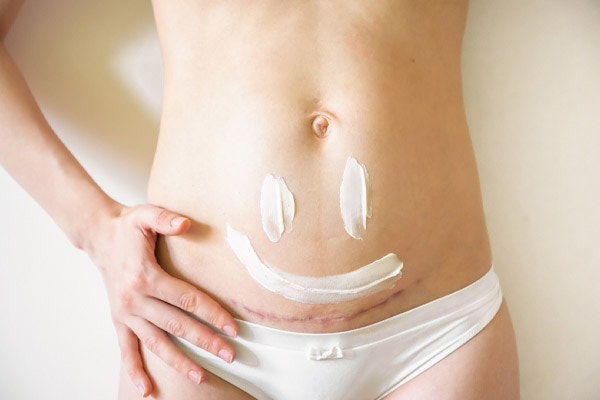When you're expecting a baby, one of the most frequent thoughts will be about the day your baby is born. Everyone has their own hopes for what that day will be like, but the simple truth is that your baby will either be born vaginally or by cesarean section. In a vaginal birth, your body will push your baby out through your birth canal, but sometimes and for lots of various reasons, a vaginal birth is not the best or safest choice for your or baby. In those instances, a c-section will be discussed. A cesarean delivery is a surgical procedure where an incision is made just above your pubic bone so that you can birth your baby through your abdomen.
The World Health Organization recommends a maximum cesarean section rate of 15%, as rates above 10% are not associated with improvements in maternal and neonatal outcomes. In the United States the cesarean rate is currently over 31%, which means about 1 in 3 babies are born by c-section. With the Caesarean section rate being so high in our country, it's a good idea for all expecting parents to be familiar with the procedure and to know what your options are with a surgical birth.
What are the reasons for a cesarean section?
As you get closer to your estimated due date, your doctor may bring up the option of a c-section for a number of reasons. Some of the most common are:
1. Placenta placement. In some pregnancies, the placenta implants low in the uterus and occasionally it can cover the cervix. This is called placenta previa. The cervix is the part of the uterus that opens up for baby to be born, so if that spot is covered by the placenta then as the cervix opens and dilates the placenta will detach, which is life threatening for baby. In cases of placenta previa a vaginal delivery is not possible and the only way for a baby to be born is by cesarean section.


4. Maternal medical conditions. If you have health problems, such as heart or blood pressure issues, labor may not be in the best interest of you and baby. If your doctor suspects that the stress of labor may be too much for your body, they will discuss a c-section delivery with you.
5. Baby's size. According to Evidence Based Birth, a doctor suspecting that your baby is big (weighing more than 8 lbs 13 oz) is the 5th most common reason for having a cesarean section. Unfortunately, when your doctor suspects your baby is large they are only right about half of the time. While there are complications that can arise when giving birth to a large baby, in the absence of diabetes, it takes nearly 3,700 c-sections to prevent one birth injury that could come from having a big baby.


2. Maternal Infection. If you have an uncontrolled HIV infection or an active Herpes breakout at the time of delivery, the safest way for your baby to be born is by c-section. Both of these illnesses can be passed on to baby and can be life threatening. Having a surgical delivery will help keep your baby healthy.
3. Baby's position. Your baby's position affects their ability to be able to navigate through your pelvis and be born vaginally. Some babies are not well positioned at birth and instead of labor contractions helping them move through the birth canal, the labor stresses baby and causes changes in their heart rate. In addition, many providers are no longer trained in breech birth deliveries, so if your baby is bottom down and their head is up at delivery, this could also lead to a cesarean delivery.
6. Multiples. If you are carrying multiple babies, your doctor may discuss a cesarean delivery with you during your prenatal care.
The above situations are things that you and your provider can discuss during pregnancy to decide which birth options are best for your family, but there are situations that can arise during labor that could also mean that a c-section would be optimal for you and baby. Some of those situations are:
1. Fetal Distress. Labor is hard work for your baby and sometimes babies don't handle the stress of contractions well. Your baby communicates their well-being through their heart rate, which is why your provider will be monitoring it while you're laboring. If they notice certain changes in your baby's heart rate they may discuss a cesarean delivery.
2. Labor Dystocia. Although there is not one set definition for how quickly labor should progress, once you are in active labor (at least 6 cm dilated) you should continue to progress through labor, meaning your contractions shouldn't stop and you shouldn't stay at the same dilation for many hours. If those things do happen or if you are pushing for more than 4 hours as a first time mom (or 2 hours if you've given birth before) then your doctor might bring up a cesarean delivery as the best choice for you and baby.
3. Cord prolapse. At some point in time before your baby is born, the amniotic sac that surrounds your baby will break and you will have a gush or a trickle of fluid come out. When your water breaks, especially if your baby's head isn't well engaged in your pelvis, part of the umbilical cord can come out in front of baby's head. This is called a cord prolapse and it is an emergency situation that is only able to be resolved by delivering your baby via cesarean section as quickly as possible.
If for any reason you are having an emergency c-section, your healthcare providers may not have time to administer those medications and you may be given general anesthesia and sleep through the procedure--thankfully that isn't usually the situation! As part of the preparations, you will have an intravenous line started in one of your arms. This IV access will allow you to receive fluids and medications, such as antibiotics, during the surgery. After the medications have started to work and your lower half is numb, your nurses will shave your lower abdomen, if necessary, and clean the skin with an antiseptic cleaner.


What to expect during a cesarean delivery:
Your nurse will encourage you to walk around as soon as you are able and may even put a compression device on your legs to encourage blood flow and prevent the development of blood clots. You will be quite sore for the first 2 to 4 days following the surgery, but your doctor will prescribe pain medication that you can take, as needed. A heating pad and abdominal compression can also help keep you comfortable as the incision heals.
Your incision will heal slowly over the next 6 to 8 weeks. The first step of healing is for the wound itself to close. After that, your body will begin filling in scar tissue around the incision. Doing scar massage as soon as you are able will help keep the scar tissue from getting too thick or forming adhesions to other tissue and organs around it. Using Motif Medical's C-Section Bandages will also help minimize scarring and discomfort around your incision site. These bandages are a three step system to help promote healthy healing of the wound while keeping you comfortable by reducing pulling and tugging as you move around.


If you're planning a c-section or if you and your doctor decide during your labor that a cesarean birth is the best option for you and baby, it is helpful to know what to expect. The first thing that will happen is you will be given an epidural, if you don't have one already, or a spinal block. These medications will numb your abdomen but you will still be awake and conscious of what is going on.
A urinary catheter will be placed to keep your bladder empty. Your abdomen will be draped with sterile cloths and a drape will be hung at your chest to protect the surgical area. Some people are able to request a clear drape so they can watch their baby being born, so make sure to ask your doctor about that option if you're interested in it!
When you are prepped and ready your partner or support person will be brought into the operating room with you. They will get to sit by you to talk with you and hold your hand. When everyone is in place, the surgeon will make an abdominal incision just above your pubic hair. In most cases, a low transverse incision is made through the skin and uterus (your abdominal muscles aren't cut, they are moved out of the way). In cases of emergencies or malpositioned of baby, your doctor may need to cut a vertical incision. You shouldn't feel any pain with the surgery, but you may feel some pulling and tugging as the doctor is working. If you do feel pain, make sure to let the anesthesiologist know--they will be sitting right by your head to make sure you are doing well and staying comfortable. Once the uterine incision is made, your delivery team will help your baby be born through your abdomen. Because your baby has not been squeezed through the birth canal, please know they often need a little additional stimulation before they cry. Once your baby is screaming hello, your doctor will hold your beautiful baby up for you to see. If baby is doing well, many medical teams can practice delayed cord clamping as part of a cesarean delivery, if that's something you let them know you want. Next, the cord will be clamped and cut and your baby will be taken over to a warmer that has been set up in the operating room for the nursing team to assess and clean your baby. After baby is bundled, a nurse will bring your baby over to you and some moms are even able to start breastfeeding while they are still in the operating room!
After your baby is born, your doctor will deliver your placenta and begin suturing the incision site. They will use dissolvable sutures that won't need to be removed and most use a double suture closure, as this gives more thickness to the myometrial layer of the uterus and reduces the risk of uterine rupture in future pregnancies and increases the likelihood of having a successful vaginal birth after cesarean (VBAC). After your incision is closed and bandaged, you will be taken to a recovery room where a nurse will monitor your vitals for the first several hours and also keep an eye on your blood loss, help you with breastfeeding, and help you manage your pain. You will still have an IV connected that will be providing you with fluids and antibiotics prevent an infection from occurring. Whether you had a elective, planned c-section or an emergency cesarean delivery, your hospital stay will likely be at least 48 hours after birth. Because your baby was born via major surgery you are at increased risk for heavy bleeding and blood clots.
After your baby is born, it's important to prioritize rest in the immediate postpartum. When you are home and recovering from your c-section, let your family and friends step up to take care of you and your home so that you can focus on giving yourself the time and space to heal from birth. Because after your baby is here, all you really need to do is rest and bond with your new baby!
Resources:
1. World Health Organization. "WHO Statement on Cesarean Section Rates." 2015 April. https://www.who.int/reproductivehealth/publications/maternal_perinatal_health/cs-statement/en/
2. Centers for Disease Control and Prevention. "Births-Method of Delivery. 2019. https://www.cdc.gov/nchs/fastats/delivery.htm
3. Evidence Based Birth. "Evidence on Induction or Cesarean for a Big Baby." August 21, 2019. https://evidencebasedbirth.com/evidence-for-induction-or-c-section-for-big-baby/








